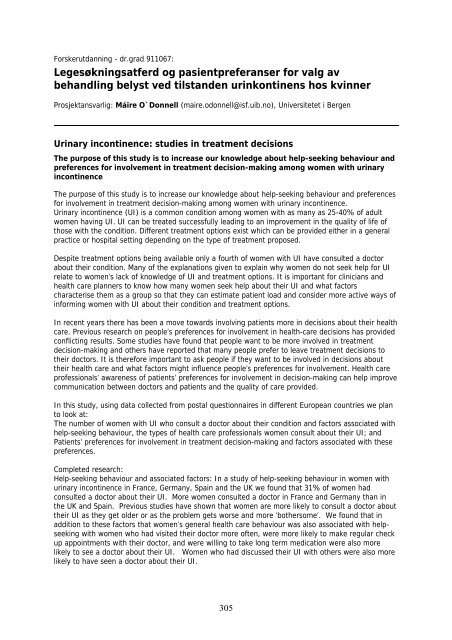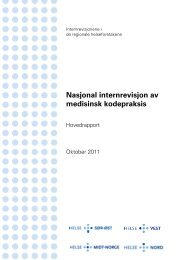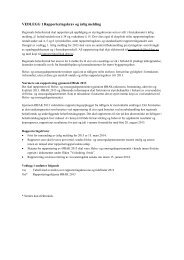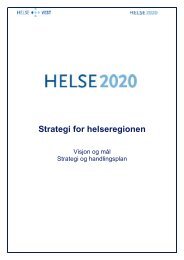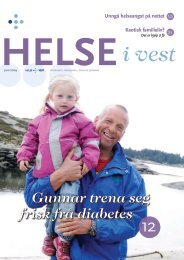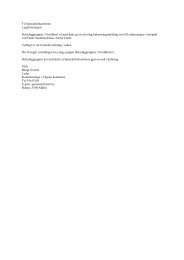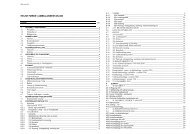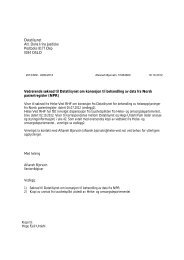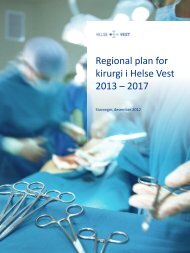- Page 3 and 4:
Lerfald S, Thorstensen RCFaglig rap
- Page 7 and 8:
Kalland, Karl-Henning .............
- Page 9 and 10:
Figur 1: Vitenskapelige publikasjon
- Page 11 and 12:
Nasjonale og regionale funksjonerHv
- Page 13 and 14:
KvalitetsregistreDet er rapportert
- Page 15 and 16:
Forskningsproduksjon 2005Det er rap
- Page 17 and 18:
Årets topplisterTabell 4: Topplist
- Page 19 and 20:
Belønning av produktive forsknings
- Page 21 and 22:
Regionalt kompetansesenter RK-HB4:K
- Page 23 and 24:
Jaran Apold, Azadeh Badiee, Ove Bru
- Page 25 and 26:
Endringer i aktivitet i forhold til
- Page 27 and 28:
"Identifisering av genforandringer,
- Page 29 and 30:
Nytt i 2005 var også at senteret h
- Page 31 and 32:
adult population."Int J Tuberc Lung
- Page 33 and 34:
Regionalt kompetansesenter RK-HB2:K
- Page 35 and 36:
Bell RF"[Painful pains]"Tidsskr Nor
- Page 37 and 38:
Endringer i aktivitet i forhold til
- Page 39 and 40:
Regionalt kompetansesenter RK-HB5:K
- Page 41 and 42:
Wiker H"Stafylokokkinfeksjoner"Fagl
- Page 43 and 44:
Nasjonalt kompetansesenter og lands
- Page 45 and 46:
3 pågående forskningsprosjekter v
- Page 47 and 48:
Endringer i aktivitet i forhold til
- Page 49 and 50:
Aarsland D, Janvin C"Cognitive Impa
- Page 51 and 52:
Nasjonalt kompetansesenter for lege
- Page 53 and 54:
Nøkkeltall 2005• 7,4 årsverkEnd
- Page 55 and 56:
Lie SA"Results of Uncemented Cup Re
- Page 57 and 58:
Nasjonalt kompetansesenter NK-HB4:N
- Page 59 and 60:
Torkildsen O, Utsi E, Harbo HF, Mel
- Page 61 and 62:
Dahl J, Myhr KM, Gilhus NE, Daltvei
- Page 63 and 64:
Haugstad, Randi"Compliance ved immu
- Page 65 and 66:
lage en Web side for Det Norske Nyr
- Page 67 and 68:
Nasjonalt kompetansesenter NK-HB13:
- Page 69 and 70:
PMID: 15811392Bjorvatn B, Leissner
- Page 71 and 72:
"Depression in the postnatal period
- Page 73 and 74:
Nasjonalt kompetansesenter NK-HB11:
- Page 75 and 76:
Lehtonen MH, Laine M, Niemi J, Thom
- Page 77 and 78:
Kulseng, Siri; Skranes, Jon S; Myhr
- Page 79 and 80:
"Plastisitet i hjerne i recoveryfas
- Page 81 and 82:
Nøkkeltall 2005• 1,3 årsverkEnd
- Page 83 and 84:
Aymen Bushra Ahmed 1, Odd Helge Gil
- Page 85 and 86:
Indremedisin ved HUS og opprettet e
- Page 87 and 88:
Nasjonalt kompetansesenter NK-HB6:N
- Page 89 and 90:
911200, KorttidsstipendØyvind Skad
- Page 91 and 92:
4. Forskningssamarbeid med gastroen
- Page 93 and 94:
Nasjonalt kompetansesenter NK-HB8:N
- Page 95 and 96:
Landsfunksjon L-HB1:Avansert branns
- Page 97 and 98:
Abstract: 11th European Burn Associ
- Page 99 and 100:
Landsfunksjon L-HB4:StråleknivAnsv
- Page 101 and 102:
Flerregionale funksjon F-HB5:Behand
- Page 103 and 104:
Flerregionale funksjon F-HB1:Cochle
- Page 105 and 106:
Flerregionale funksjon F-HB4:Inters
- Page 107 and 108:
Del 3:Forskningsprosjekter 2004106
- Page 109 and 110:
Collett K, Stefansson IM, Eide J, B
- Page 111 and 112:
Korttidsprosjekt 911197:Homocystein
- Page 113 and 114:
Forskerutdanning - dr.grad 911159:K
- Page 115 and 116:
Forskningsprosjekt 911220:Molecular
- Page 117 and 118:
Gudmundsson G, Gislason T, Janson C
- Page 119 and 120:
Forskerutdanning - postdoc 911241:M
- Page 121 and 122:
Gudbrandsen OA, Dyrøy E, Bohov P,
- Page 123 and 124:
til å gå med aktigraf. Erfaringen
- Page 125 and 126:
Berstad A"[Intestinal gas--unpleasa
- Page 127 and 128:
Forskningsprosjekt 911010:A Diagnos
- Page 129 and 130:
Korttidsstipend 911189:Gir gjentatt
- Page 131 and 132:
Forskerutdanning - dr.grad 911171:I
- Page 133 and 134:
Forskningsprosjekt 911099:Eksperime
- Page 135 and 136:
Forskningsprosjekt 911126:Symptomer
- Page 137 and 138:
Korttidsprosjekt 911195:Fra sentral
- Page 139 and 140:
Forskningsprosjekt 911125:Gene and
- Page 141 and 142:
Strategiske midler - forprosjekt 91
- Page 143 and 144:
Forskerutdanning - dr.grad HVR91000
- Page 145 and 146:
Forskningsprosjekt 911109:Multiple
- Page 147 and 148:
Forskningsprosjekt 911108:Specific
- Page 149 and 150:
Forskerutdanning - dr.grad 911154:P
- Page 151 and 152:
Forskningsprosjekt 911095:Nyrenes r
- Page 153 and 154:
Olav Dahl har sammen med de andre g
- Page 155 and 156:
3. Er det forskjell i forløpet av
- Page 157 and 158:
Glimelius B, Dahl O, Cedermark B, J
- Page 159 and 160:
Forskningsprosjekt 911091:Fish hype
- Page 161 and 162:
Forskerutdanning - dr.grad 911084:S
- Page 163 and 164:
Herfindal L, Oftedal L, Selheim F,
- Page 165 and 166:
Korttidsstipend 911193:Svangerskap
- Page 167 and 168:
Forskerutdanning - dr.grad 911069:T
- Page 169 and 170:
Forskerutdanning - dr.grad 19917:Je
- Page 171 and 172:
Forskningsprosjekt 911213:Studier a
- Page 173 and 174:
Forskningsprosjekt 911006:Fosfoprot
- Page 175 and 176:
Nasjonalt kvalitetsregister 911152:
- Page 177 and 178:
Gjertsen JE, Vinje T, Fevang J, Eng
- Page 179 and 180:
Forskerutdanning - dr.grad 911087:
- Page 181 and 182:
Utstyr 911202:Optisk bildediagnosti
- Page 183 and 184:
Forskningsprosjekt 911052:Dykkerrel
- Page 185 and 186:
Phyu S, Lwin T, Ti T, Maung W, Mar
- Page 187 and 188:
Forskningsprosjekt 911221:Role of m
- Page 189 and 190:
Clin Exp Allergy. 2005;35(8):1028-3
- Page 191 and 192:
Forskningsprosjekt 911234:Anafylaks
- Page 193 and 194:
at det er forskjell i tynnfiber men
- Page 195 and 196:
Forskningsprosjekt 911229:Meistring
- Page 197 and 198:
12.30 - 13.00 Nasjonal ernæringsst
- Page 199 and 200:
Forskerutdanning - dr.grad 911068:V
- Page 201 and 202:
Forskningsprosjekt 911110:Effekt av
- Page 203 and 204:
Forskningsprosjekt 911025:Barn i Be
- Page 205 and 206:
Forskningsprosjekt 911115:Mikrometa
- Page 207 and 208:
Wester K. Gender distribution and s
- Page 209 and 210:
Forskerutdanning - dr.grad 911162:B
- Page 211 and 212:
Forskningsprosjekt 911123:Klinisk g
- Page 213 and 214:
Forskerutdanning - dr.grad 911174:E
- Page 215 and 216:
Forskerutdanning - dr.grad 911176:D
- Page 217 and 218:
5 forskningspublikasjoner (inkl. ab
- Page 219 and 220:
Raeder MB, Fernø J, Glambek M, Sta
- Page 221 and 222:
Forskningsprosjekt 911226:Kuldeindu
- Page 223 and 224:
Forskningsprosjekt 911014 & Strateg
- Page 225 and 226:
Utstyr 911191:Influenza pandemicPro
- Page 227 and 228:
Forskningsprosjekt 911105:Etablerin
- Page 229 and 230:
Bredrup C, Knappskog PM, Majewski J
- Page 231 and 232:
Forskerutdanning - dr.grad 911070:M
- Page 233 and 234:
Forskerutdanning - postdoc 911184:C
- Page 235 and 236:
from patients with acute myeloid le
- Page 237 and 238:
Forskerutdanning - dr.grad HVR91000
- Page 239 and 240:
Jonsson MV, Szodoray P, Jellestad S
- Page 241 and 242:
Forskningsprosjekt 911209:Selvmords
- Page 243 and 244:
Forskningsprosjekt 911227:Subclassi
- Page 245 and 246:
Forskerutdanning - dr.grad 911079:K
- Page 247 and 248:
Forskerutdanning - dr.grad 911177:E
- Page 249 and 250:
Forskerutdanning - dr.grad HVR91000
- Page 251 and 252:
Strategiske midler - forprosjekt 91
- Page 253 and 254:
Blomberg B, Jureen R, Manji KP, Tam
- Page 255 and 256: hjertevene. Pacemakeren som er på
- Page 257 and 258: Forskerutdanning - dr.grad 911073:A
- Page 259 and 260: disse har gjennomført baseline und
- Page 261 and 262: homocystein nivået var signifikant
- Page 263 and 264: 1 forskningspublikasjoner (inkl. ab
- Page 265 and 266: Forskningsprosjekt 911231:Antiestro
- Page 267 and 268: Strategiske midler - sterke miljøe
- Page 269 and 270: Forskerutdanning - postdoc 911183:C
- Page 271 and 272: 2 vitenskapelige artikler er publis
- Page 273 and 274: Forskningsprosjekt 911056:Langtids
- Page 275 and 276: Forskningsprosjekt 911119:Identific
- Page 277 and 278: Forskerutdanning - dr.grad 911164:A
- Page 279 and 280: Forskerutdanning - dr.grad 911157:A
- Page 281 and 282: Forskningsprosjekt 911217:Tidlig ca
- Page 283 and 284: Kristensen VN, Sørlie T, Geisler J
- Page 285 and 286: Forskerutdanning - dr.grad 911077:O
- Page 287 and 288: Forskerutdanning - dr.grad 911064:M
- Page 289 and 290: future perspectives."Leukemia. 2005
- Page 291 and 292: Tuyen Hoang, Ingvild Fenne, Ernst A
- Page 293 and 294: Forskningsprosjekt 911214:Perinatal
- Page 295 and 296: Korttidsprosjekt 911199:Relation of
- Page 297 and 298: 6 vitenskapelige artikler er publis
- Page 299 and 300: Strategiske midler - belønning NFR
- Page 301 and 302: PMID: 16245986Sagen JV, Pearson ER,
- Page 303 and 304: Forskerutdanning - dr.grad 911178:L
- Page 305: Forskningsprosjekt 911028:WENBIT -
- Page 309 and 310: PMID: 16126006Myrseth E, Møller P,
- Page 311 and 312: Korttidsprosjekt 911206:Brannskader
- Page 313 and 314: 1 forskningspublikasjoner (inkl. ab
- Page 315 and 316: Forskningsprosjekt 911130:Strålekn
- Page 317 and 318: 8 forskningspublikasjoner (inkl. ab
- Page 319 and 320: Forskningsprosjekt 911225:Differens
- Page 321 and 322: Forskningsprosjekt 911211:MR nyrer
- Page 323 and 324: Forskningsprosjekt 911113:Registerf
- Page 325 and 326: Korttidsstipend 911187:Behandling a
- Page 327 and 328: Forskerutdanning - dr.grad 911019:H
- Page 329 and 330: Forskerutdanning - dr.grad 911158:P
- Page 331 and 332: Korttidsstipend 911200:Isolerte ret
- Page 333 and 334: Forskningsprosjekt 911237:Laks, fis
- Page 335 and 336: Forskningsprosjekt 911232:The Horda
- Page 337 and 338: Forskningsprosjekt 911015:Funksjone
- Page 339 and 340: Korttidsstipend 911188:Tumorbiologi
- Page 341 and 342: Korttidsstipend 911198:Spesifikk og
- Page 343 and 344: Forskerutdanning - postdoc 911185:H
- Page 345 and 346: Forskningsprosjekt 911116:Kvinnelig
- Page 347 and 348: Forskerutdanning - dr.grad 911181:M
- Page 349 and 350: Brystkreft er en heterogen sykdom,
- Page 351 and 352: 1 doktorgrader er avlagt i 2005 med
- Page 353 and 354: Korttidsstipend 911204:Cobalamin su
- Page 355 and 356: Forskerutdanning - postdoc 911103:M
- Page 357 and 358:
Forskerutdanning - dr.grad 911156:L
- Page 359 and 360:
Arnesen T, Gromyko D, Horvli O, Flu
- Page 361 and 362:
Jørgensen L, Vedeler CA"[Miller-Fi
- Page 363 and 364:
2 doktorgrader er avlagt i 2005 med
- Page 365 and 366:
2 forskningspublikasjoner (inkl. ab
- Page 367 and 368:
Strategiske midler - sterke miljøe
- Page 369 and 370:
Eide MG, Øyen N, Skjaerven R, Irge
- Page 371 and 372:
Forskningsprosjekt 911215:Etterunde
- Page 373 and 374:
Forskerutdanning - postdoc 911186:G
- Page 375 and 376:
Forskerutdanning - dr.grad 911075:H
- Page 377 and 378:
Forskningsprosjekt 911212:Extrapulm
- Page 379 and 380:
og om disse proteinene kan utnyttes
- Page 381 and 382:
1 vitenskapelige artikler er publis
- Page 383 and 384:
Forskerutdanning - dr.grad 911165:F
- Page 385 and 386:
Manglende rapporteringNoen prosjekt
- Page 387 and 388:
Tematisk stikkordsliste i henhold t
- Page 389 and 390:
Helland, C: Klinisk, radiologisk og
- Page 391 and 392:
Lærum, B: Astma og allergi hos ung
- Page 393 and 394:
Lybæk, H: Anvendelse af mikromatri
- Page 395:
ISBN 82-8045-012-2394


